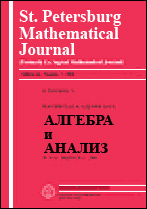|
Research Papers
Numerically detectable hidden spectrum of certain integration operators
N. Nikolskiab
a St. Petersburg State University, Chebyshev Laboratory, 199178, St. Petersburg, Russia
b University of Bordeaux, France
Abstract:
It is shown that the critical constant for effective inversions in operator algebras $alg(V)$ generated by the Volterra integration $Jf=\int_0^xf\,dt$ in the spaces $L^1(0,1)$ and $L^2(0,1)$ are different: respectively, $\delta_1=1/2$ (i.e., the effective inversion is possible only for polynomials $T=p(J)$ with a small condition number $r(T^{-1})\|T\|<2$, $r(\cdot)$ being the spectral radius), and $\delta_1=1$ (no norm control of inverses). For more general integration operator $J_\mu f=\int_{[0,x>}f\,d\mu$ on the space $L^2([0,1],\mu)$ with respect to an arbitrary finite measure $\mu$, the following $0-1$ law holds: either $\delta_1=0$ (and this happens if and only if $\mu$ is a purely discrete measure whose set of point masses $\mu(\{x\})$ is a finite union of geometrically decreasing sequences), or $\delta_1=1$.
Keywords:
effective inversion, visible spectrum, integration operator.
Received: 25.06.2016
Citation:
N. Nikolski, “Numerically detectable hidden spectrum of certain integration operators”, Algebra i Analiz, 28:6 (2016), 70–83; St. Petersburg Math. J., 28:6 (2017), 773–782
Linking options:
https://www.mathnet.ru/eng/aa1514 https://www.mathnet.ru/eng/aa/v28/i6/p70
|


| Statistics & downloads: |
| Abstract page: | 262 | | Full-text PDF : | 50 | | References: | 50 | | First page: | 12 |
|





 Contact us:
Contact us: Terms of Use
Terms of Use
 Registration to the website
Registration to the website Logotypes
Logotypes








 Citation in format
Citation in format 